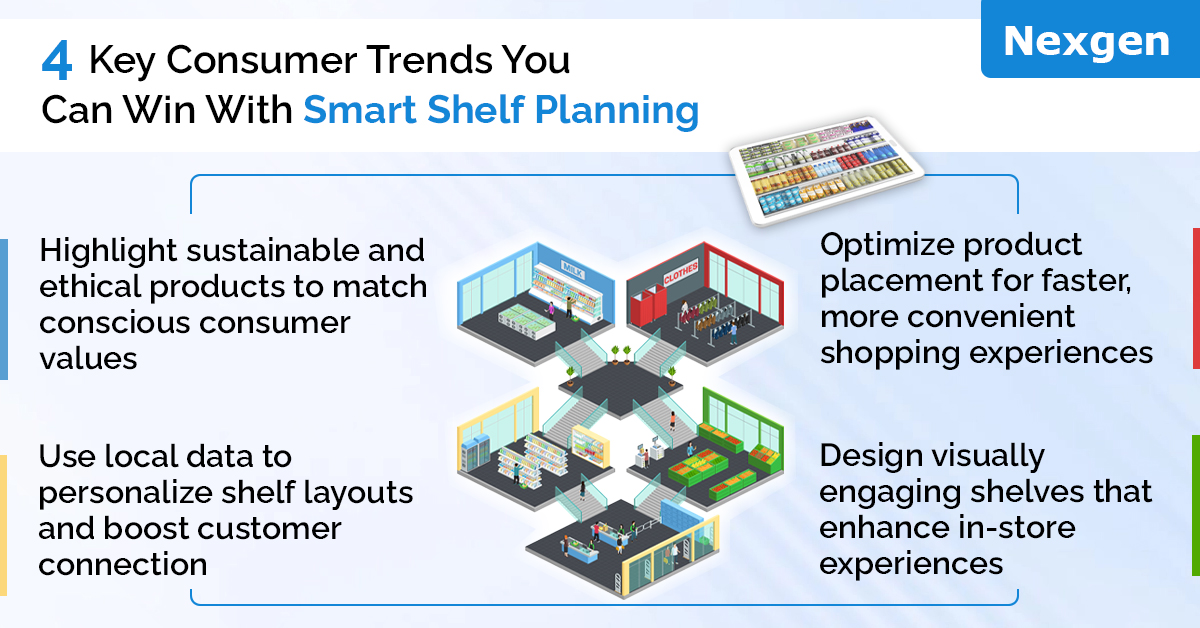The retail landscape is undergoing a significant transformation as consumer preferences and behaviors continue to evolve. Retailers must stay ahead by understanding the key insights driving these changes. Here are four critical consumer insights shaping the future of the retail industry:
1. Demand for sustainability and ethical practices.
Today's consumers are increasingly mindful of their environmental and social impact. They expect retailers to adopt sustainable practices, from sourcing ethically produced goods to reducing packaging waste. Shoppers are also more inclined to support brands with transparent supply chains and commitments to sustainability goals.
What Retailers Can Do:
- Implement eco-friendly initiatives such as offering recyclable packaging or using renewable energy in stores.
- Highlight products using shelf space planning, that meet ethical standards, such as fair trade or organic certifications.
- Educate consumers about your sustainability efforts through in-store signage and digital channels.
2. Rise of personalized shopping experiences.
Consumers crave personalization more than ever. Whether shopping online or in-store, they expect retailers to tailor their experiences based on their preferences, purchase history, and behaviors.
What Retailers Can Do:
- Use data analytics and AI to deliver personalized product recommendations and promotions.
- Design store layouts and planograms that cater to local customer preferences.
- Leverage mobile apps and loyalty programs to create bespoke shopping journeys.

3. Emphasis on convenience and speed.
The rise of e-commerce has heightened consumer expectations for convenience and speed. Shoppers value seamless experiences, quick delivery, and easy returns.
What Retailers Can Do:
- Optimize fulfillment strategies by investing in micro-fulfillment centers and dark stores.
- Simplify the checkout process with self-service kiosks and mobile payment options.
- Provide omnichannel solutions, such as buying online, pick up in-store (BOPIS) and curbside pickup.
4. Emphasis on convenience and speed.
Despite the growth of online shopping, physical stores remain relevant as spaces for unique and engaging experiences. Shoppers are drawn to stores that offer more than just products, they seek interaction, inspiration, and entertainment.
What Retailers Can Do:
- Incorporate interactive displays and virtual reality (VR) experiences to captivate shoppers.
- Host events, workshops, or product demonstrations to foster community engagement.
- Create visually appealing and sensory-rich environments to enhance the in-store experience.
Final Thoughts
Retailers who adapt to these consumer insights will be well-positioned for success in the rapidly changing market. By prioritizing sustainability, personalization, convenience, and experiential retail and leveraging tools like planograms to optimize shelf layouts and product placement, businesses can meet evolving consumer expectations and drive long-term loyalty.
As we move forward, the retail industry will continue to be shaped by innovative technologies and changing consumer demands. Staying attuned to these trends will help retailers not only survive but thrive in the competitive landscape.
Overview of Nexgen POG
Nexgen POG is a robust and user-friendly cloud-based visual merchandising tool. It is designed for quick and efficient planogramming with minimal effort. Planogram in retail can be designed by easily dragging and dropping the products. The multi-device compatibility feature of POG allows you to obtain, share and edit planogram on any device, including your phone. It helps in designing store-specific planograms for increased product visibility and sales.
Get Your Free Trial Now!